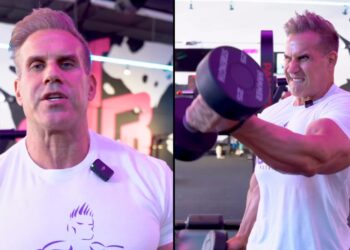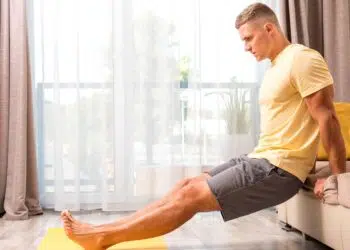If you train in a gym, then chest training is a relatively straightforward process. All you need to do is pump out a few sets of barbell bench presses, cable crossovers, and pec deck flys, and you’re done! Of course, you’ll get better results if you follow a more structured plan. Still, the reality is that, when it comes to available exercises, you’ve got plenty to choose from.
But what if you train at home, or just can’t make it to the gym on chest day? What can you do to build and strengthen your pecs then?
The good news is that there are lots of chest exercises you can do at home, using nothing more than your body weight or a pair of dumbbells and an adjustable exercise bench.
Bodyweight Chest Exercises
Most of the best chest exercises you can do at home are variations of push-ups. Push-ups use the same muscles and movement patterns as barbell bench presses, dumbbell bench presses, and most chest press machines too. Don’t think for a minute that push-ups are boring or ineffective; they aren’t, and there are lots of different variations to try.
Whether you are a beginner or a champion bodybuilder, there is a type of push-up that’s right for you. Here are ten of the best:
1 – Basic push-ups
This is the exercise you need to master before trying any of the following variations. It will teach you the skills necessary to do safe and effective push-ups.
Level Up Your Fitness: Join our 💪 strong community in Fitness Volt Newsletter. Get daily inspiration, expert-backed workouts, nutrition tips, the latest in strength sports, and the support you need to reach your goals. Subscribe for free!
- Kneel down and place your hands on the floor with your fingers pointing forward and slightly wider than shoulder-width apart.
- Walk your feet back until your legs and hips are straight. Your palms should be next to your lower chest on each side.
- Brace your abs and look straight down to the floor, so your neck is neutral. Without moving your hands, rotate your upper arms outward to activate your lats, and stabilize your shoulders.
- Bend your arms and, without bending at the hips or craning your neck, lower your chest down to within an inch of the floor.
- Extend your arms and push yourself back up to full arm extension. Straighten, but don’t lock your elbows.
If full push-ups are too demanding, bend your legs and rest your knees on the floor. This takes some of the weight off your hands, making this exercise easier.
2 – Incline push-ups
If full push-ups are too much for you right now, but kneeling push-ups are too easy, give incline push-ups a try. Do your push-ups as described above but put your hands on a raised surface, such as a countertop, sturdy chair, or even a wall. Graduate to lower surfaces as you get stronger, working toward doing your push-ups with your hands on the floor.
3 – Decline push-ups
Once you have mastered basic push-ups, you’ll soon be ready for a more demanding chest exercise. Decline push-ups put more stress on your triceps, upper pecs, and deltoids. To do this exercise, place your feet on a knee-high chair or step. Your body should be roughly parallel to the floor.
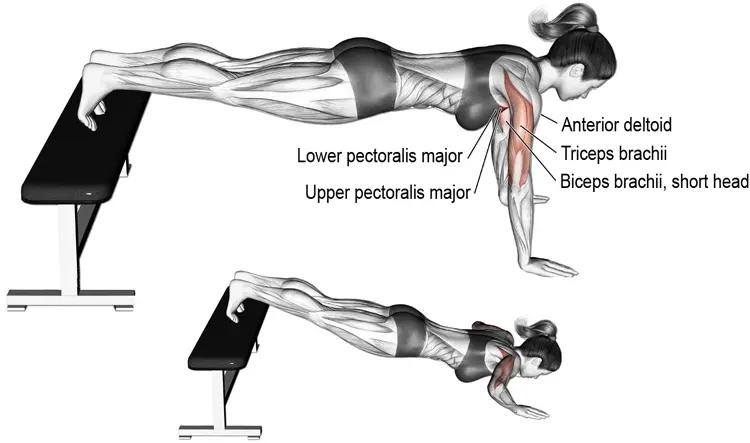
Despite being more demanding, make sure you do not arch your lower back when doing this exercise as it could lead to injury.
4 – Deficit push-ups
When you do push-ups, your range of motion comes to an abrupt halt when your chest touches the floor. Increasing the range of motion will make push-ups harder, and also provide your chest with an additional stretch. Place your hands on a couple of thick books, bricks, or use push-up handles so that you can lower your chest down between your hands. Be careful not to overextend your shoulders, as this could lead to injury.
5 – Plyo push-ups
Plyometric push-ups, or plyo push-ups for short, are a fast, explosive movement that will increase muscle power. Power is your ability to generate force very quickly and is important in activities like punching and throwing. Plyo push-ups also increase muscle activation and will have a positive impact on both muscle strength and size.
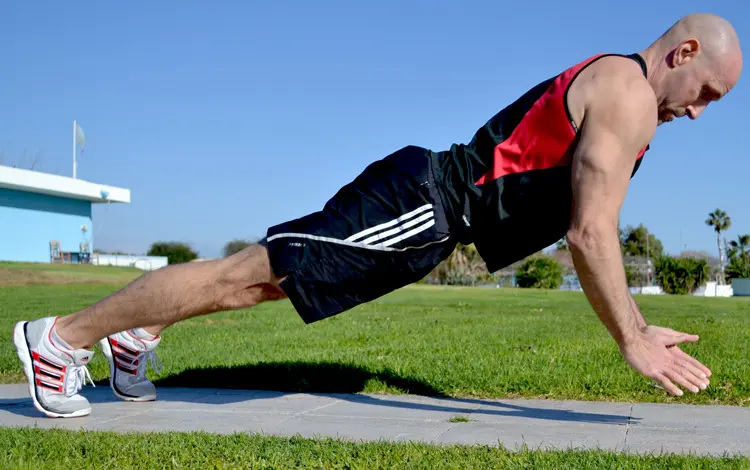
To do this exercise, adopt your normal push-up position, bend your arms, lower your chest to the floor, and then extend your arms as fast as you can. Push your upper body off the floor so forcefully that your hands leave the floor. Land on slightly bent elbows and repeat. This exercise can be hard on your wrists, so do it on a mat. Avoid this one if you have a history of wrist or hand injuries. You can also do plyo push-ups on your knees.
6 – Walking push-ups
This exercise adds an extra element of movement and instability to your push-ups. Slightly harder than basic push-ups, this is a good exercise for adding variety to your chest-building workouts.
Adopt your normal push-up position with your hands on a low platform, such as an aerobic step box top. Step one arm out and down to the side and do a single push-up. Bring your hands back together on your platform and then do another rep out to the other side. Continue alternating arms for the duration of your set.
7 – Offset push-ups
Off-set push-ups bridge the gap between basic push-ups and single-arm push-ups. They increase the weight on one arm, making this exercise a little harder than the regular type of push-up.
Adopt your normal push-up position but then move one hand down your body, so it’s below your hip on the floor. In this position, your lower arm will not be able to generate as much force as usual, forcing your other arm to do more of the work. Do all your reps on one side, rest, and then swap your arms around and repeat.
8 – One-arm push-ups
Arguably the most advanced type of push-up you can do, this testing exercise will develop strength, muscle size, and power in equal measure. It’s also a very challenging core exercise as you’ll have to work extra hard to keep your body rigid and straight.
From your normal push-up position, move one hand in so it’s directly under the center of your chest. Place your other hand behind your back. While trying not to twist your hips or shoulders too much, bend your arms and lower your shoulder down your hand. Keep your abs tightly braced. Push back up and repeat.
If this exercise is too challenging for you right now, you can do it on your knees or with your hand on an elevated surface to take some of the weight off your arm. You can also spread your feet out a little further than the standard push-up position for better balance and stability.
9 – Band push-ups
While push-ups are undeniably a bodyweight exercise, that doesn’t mean you can’t use external forces to make them harder. Using a resistance band makes all types of push-ups more demanding, especially as your arms approach lock-out.
Level Up Your Fitness: Join our 💪 strong community in Fitness Volt Newsletter. Get daily inspiration, expert-backed workouts, nutrition tips, the latest in strength sports, and the support you need to reach your goals. Subscribe for free!
Take a resistance band and loop it over your back. With the end ends of the band in your hands, adopt the starting position of whichever type of push-up you are doing and rep out as normal. However, you probably won’t be able to do as many repetitions as usual.
10 – Weighted push-ups
Another way to make push-ups more demanding is to increase your body weight. And no, we don’t mean you need to get fat! Wearing a weighted vest or a backpack will make push-ups much more demanding. Start off with about 10% of your body weight in your vest/pack and go from there.
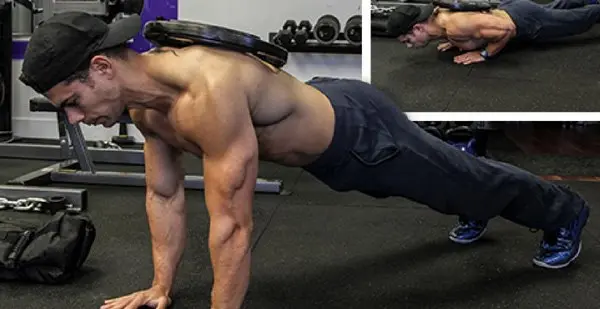
If you are working out with a partner, you could also ask them to carefully rest a weight plate across your upper back.
Push-up Summary
There is nothing to stop you from combining different push-up exercises and methods to make your ideal at-home chest workout. For example, if you are a push-up expert, you could do decline, weighted, plyo push-ups, or how about deficit push-ups with bands. However strong you are, there is a way to make push-ups hard enough for you.
While push-ups are arguably the most convenient way to work your chest using just your body weight, there are a couple more options you can use.
1 – Dips
Parallel bar dips are a common gym and gymnastic training exercise that works your pecs, triceps, and deltoids. Don’t worry that you don’t have parallel bars at home, you can still do this exercise.
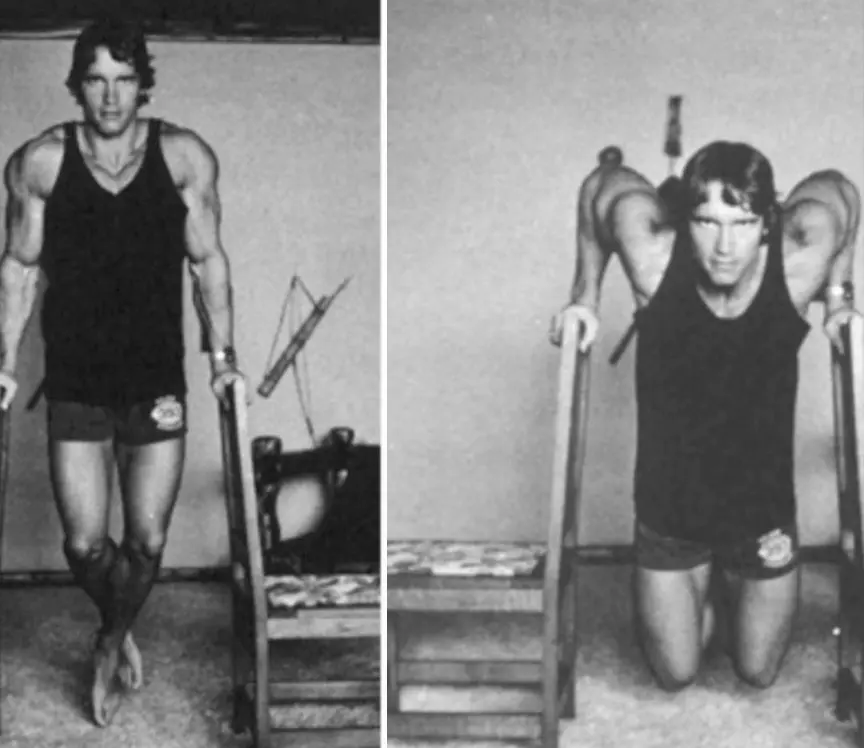
- Place two sturdy chairs or stools slightly wider-than shoulder-width apart. Stand between them and place your hands on the seats, fingers pointing forward. Support your weight on your arms and bend your legs.
- Bend your arms and descend until your upper arms are roughly parallel to the floor.
- Push back up and repeat.
This exercise can be hard on your shoulders, especially if you descend too far down. Avoid it if you have a history of shoulder problems, and stop if this exercise causes you discomfort.
2 – Towel slide flys
Push-ups and dips are compound exercises. That means they involve movement at more than one joint at a time. Exercises like flys and cable crossovers are isolation exercises that involve movement at just one joint.
Towel slide flys are one of the few bodyweight isolation exercises for your chest.
- Adopt the push-up position on a smooth floor with a towel under each hand. Bend your arms slightly, and then keep them rigid throughout.
- Open your arms and slide your hands apart, lowering your chest toward the floor.
- Squeeze your arms together and return to the starting position
- Bend your legs and rest on your knees to make this exercise easier.
Dumbbell Chest Exercises
If you have a pair of dumbbells and an adjustable bench at home, you have everything you need to build and strengthen your chest. Here are the six best dumbbell chest exercises.
1 – Dumbbell bench press
Dumbbell bench presses are potentially a better muscle builder than barbell bench presses. Why? Because they allow for a greater range of motion and arm adduction while involving more stability and control.
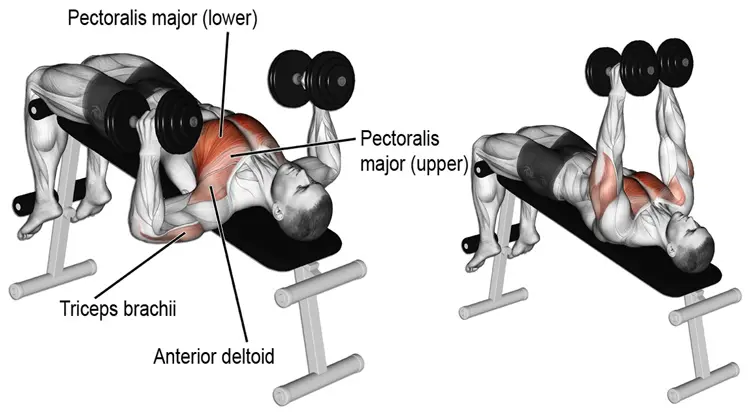
This makes them harder and more productive. Dumbbell bench presses are also easier on your shoulders.
- Lie on your bench with a dumbbell in each hand. Hold your weights over your shoulders with your palms facing down your body. Pull your shoulders down and back, brace your abs, and plant your feet firmly on the floor.
- Tuck your elbows in slightly at about 45 degrees to your sides.
- Bend your arms and lower the weights down to the outside of your shoulders. Descend as far as is comfortable, but without hyperextending your shoulders.
- Push the weights back up and repeat.
2 – Incline dumbbell bench press
Incline dumbbell bench presses emphasize the upper or clavicular portion of your chest. Do the exercise as described above but with your bench set to a 15 to 30-degree angle. Do not use a steeper angle. Doing so increases shoulder activation while decreasing the amount of work done by your pecs.
3 – Decline chest press
Decline chest presses emphasize your lower or sternal pecs. If your adjustable bench has a decline setting, set it to about 10 to 15 degrees, so your head is below your hips. No decline option? Just raise the foot of your bench by placing it on sturdy blocks.
4 – Dumbbell flys
Dumbbell bench presses involve your triceps as well as your pecs. Dumbbell flys involve much less triceps activity as your arms should stay rigid during this exercise. This means you won’t be able to use as much weight as you do for dumbbell bench presses, but most of that weight will be supported by your chest.
- Lie on your bench with a dumbbell in each hand. Press them up to arms’ length. Turn your hands, so your palms are facing inward. Bend your elbows slightly and then keep them rigid.
- Open your arms and lower the weights down and out to the side. Stretch your chest, but do not hyperextend your shoulders.
- Squeeze the weights back together over your chest and repeat.
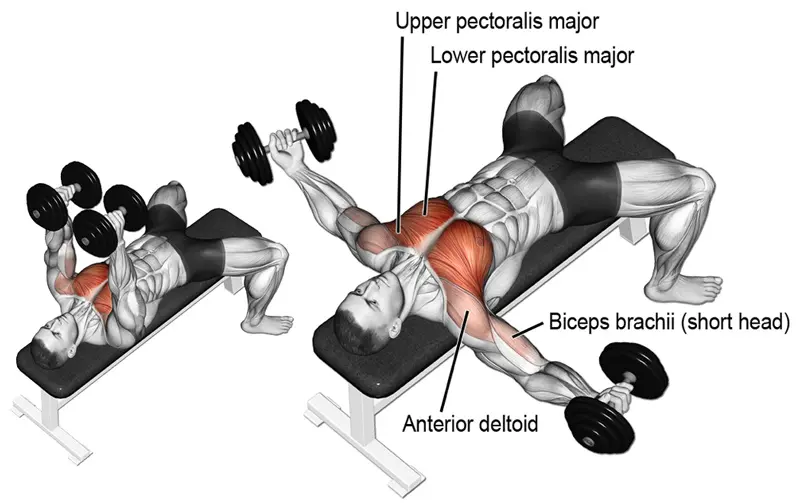
5 – Incline dumbbell flys
Perform as above but set your bench to a 15 to 30-degree angle to emphasize your upper chest.
6 – Decline dumbbell flys
Perform as above but with your bench set to a 10 to 15-degree decline to emphasize your lower chest.
At-home bodyweight and dumbbell chest workout
Not sure how to combine all these exercises into a workout? Don’t worry – we’ve got you covered! Make sure you warm-up for a few minutes before trying this workout. Do a few minutes of jogging or jump rope to get your blood pumping, followed by dynamic chest stretches and shoulder mobility exercises. Finally, do a couple of easy sets of the first 1-2 exercises to fully prepare your muscles and joints for what is to come. Do this workout once or twice per week, on non-consecutive days, e.g., Monday and Thursday.
Ready? Let’s do this!
- Decline push-ups: 4 sets of as many reps as possible (AMRAP)
- Incline dumbbell presses: 4 sets of 8-12 reps
- Dips: 4 sets of AMRAP
- Dumbbell flys: 4 sets of 12-15 reps
- Triple push-up drop sets*: 1 set of AMRAP
FAQs
Do you have any home chest training questions? We’ve got answers! If you can’t find the information you are looking for below, drop us a line in the comments section, and we’ll get back to you as soon as we can.
How often can I do this workout?
Your chest is just one of your major muscle groups. You need to spend time training your back, legs, shoulders, arms, and abs too. Because of this, you should only train your chest once or twice per week, leaving you time and energy to spend on the rest of your body.
I don’t have any dumbbells. Can I still build my chest with just bodyweight exercises?
Most definitely! Your body can’t really tell the difference between free weight, machine, cable, or bodyweight exercises – it just knows tension and work. Providing you work hard enough, you can definitely build muscle using nothing but bodyweight exercises. Not convinced? Check out the upper body development of most male gymnasts. They train almost exclusively with bodyweight exercises.
I’ve only got light dumbbells – can I still do these workouts?
Yes, you can. Make your light dumbbells feel heavier by using a slow tempo, such as lifting in four seconds and lowering in four seconds, or by taking shorter rests between sets, e.g., 30-45 seconds. You can also do more than the prescribed number of reps.
I can’t do a single basic push-up – help!
This problem is not as uncommon as you might think. A lot of people struggle with push-ups. The best way to get better at push-ups is to start with the easiest version you can manage and do a lot of reps spread throughout your day. Fitness experts call this “greasing the groove.” Do a couple of reps every waking hour or two so you clock up a good volume of reps each day. Your strength will soon improve, and you’ll be able to progress to a slightly harder type of push-up.
You can also do band-assisted push-ups, where you use a strong band to support some of your bodyweight.
I don’t have a bench. Do you have an alternative for the dumbbell exercises?
You can do dumbbell bench presses and flys lying on the floor. This will reduce your range of motion, but at least you’ll still be able to do these movements. You can also use a properly inflated exercise ball as a makeshift bench. However, you should only use a non-burst ball and also be aware that the ball may move under you, making you feel very unstable.
Wrapping up
Training at home does not have to mean missing out on your chest workout. You might not be able to do barbell bench presses, but there are still lots of different chest exercises available to you. After all, we just listed TEN different push-ups!
It’s easy to become focused on what exercises you can’t do at home when you should really be thinking about what you can do instead. Use these exercises and the workout to build a chest you can be proud of, even if you are limited to training at home.






